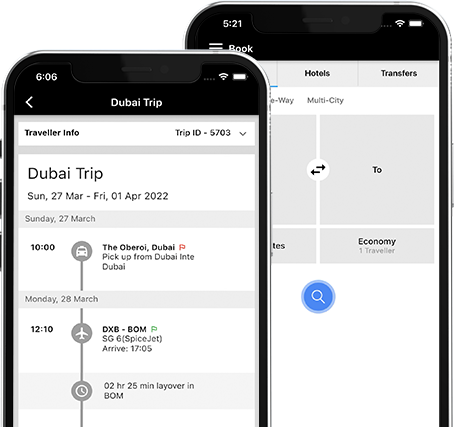Among all controllable business costs, business travel and subsistence expenses rank second highest after employee wages. Business travel expenses are imperative as employees, business owners, and consultants must travel for myriad reasons. These include business expansion, project work, customer retention, client servicing, networking, training, and branch office management. Business travel is a principal driver of MICE tourism, catering to meetings, incentives, Exhibitions, and conferences, bringing large groups of employees, professionals, traders, and consultants together. Business trip expense covers a broad spectrum of costs comprising transportation, accommodation, meals, and other incidental expenses.
Organizations strive to control business travel costs while ensuring a better travel experience and policy compliance for the well-being of employees. Online expense and travel management software programs like Paxes help businesses control every business trip expense to improve ROI.
Types of business trip expenses
A business trip expense can include several expense heads according to the travel and expense policy of the individual organization. Each company develops its own travel policies according to the travel budget, business travel objectives, travel frequency, geographical coverage, and the number of employees undertaking business trips. These are standard types of business trip expenses in most business setups.
1. Transportation expenses
The cost of transportation to reach business destinations may include airfare, rail ticket, or fuel expenses. Companies can decide the type of transportation employees should use besides the reimbursement process. These may include toll and parking expenses. Reimbursing mileage at actual is common practice if employees use personal vehicles for business travel.
2. Accommodation expenses
Employees stay at hotels when going to outstation locations on business assignments. They need accommodation in upscale hotels, providing a safe and comfortable stay. Businesses also decide these hotel accommodation expenses for an employee.
3. Subsistence expenses
Employees must spend for food during business travel to sustain themselves. Companies reimburse bills for breakfast, lunch, and dinner. All organizations allow employees to claim subsistence expenses for categories such as food and drinks.
4. Ancillary expenses
Finance teams and travel managers should list types of personal expenses, such as laundry, office stationary, tips, commuting, and entertainment expenses. These are minor expenses to support business travel.
What are the business travel expenses that employees can claim?
The following business travel and subsistence expenses qualify for reimbursement that the employee claims by submitting expense reports.
- Travel expenses: Expenses for traveling by train, bus, plane, or car to the business destination from home.
- Use of the personal car: Employees using a personal car for business travel can claim mileage reimbursement.
- Ground or local transportation: Local transport such as cab service or public transport to travel between hotel and business location or airport and hotel.
- Shipping expenditure: Expenditure for shipping baggage, exhibition display material, equipment, samples, and other material for business events.
- Hotel stay: Expenses for temporary accommodation like lodging and hotel expenses. These comprise expenses for food and drink for self.
- Laundry expenses: Employees can claim dry-cleaning and laundry expenses while on a business trip.
- Official communications: Communication costs (Wi-Fi, telephone, and courier charges for business purposes).
Business travel cost: how can you calculate it?

Real-time tracking and monitoring of travel expenses are necessary for calculating travel expenses. Online travel management platforms enable finance teams to get real-time analytics and reports. They can determine travel expenses by employees, teams, departments, and routes for a particular period.
- Create a comprehensive business travel budget template in excel format to track monthly travel expenses to assess budget utilization.
- Recording every travel expense detail is challenging unless one uses an advanced software program. Enter trip details such as type of trip, type of expense, employee name, travel destination, and department into a business trip expenses excel template.
- Calculate travel costs by summing up all expenditures under different heads, like accommodation and transportation.
- SaaS-based travel management tools like Paxes allow the categorization of every expense to determine areas that account for higher travel costs.
Required documents for expense claims
To successfully claim travel expenses, one must submit numerous documents as suggested by the company. However, some of the documents are common for every organization such as:
- Travel expense claim form provided by the organization which include personal and travel details of the employee
- A copy of travel itinerary in detail should be attached with the expense claim form
- All the receipts for business travel and meal expenses should be attached to the same
- Some organizations may also require boarding pass along with the ticket
- Approvals of various parties and heads involved should be provided with the whole paperwork
Tax implications of business trip expenses
The tax implications of business trip expenses are highly dependent on the country in concern. One should consult an accountant or tax professional in the country for filing tax as per the laws of specific country. Here are some of the key takeaways that is common for most of the countries:
- Business trips expense such as transportation, meals, accommodations, etc. are tax-deductible
- Companies should provide proper documentation such as invoices, receipts, etc. to claim tax deduction
- Businesses should clearly differentiate between personal and corporate expenses
- One should consult a tax professional for reimbursement regulations and international trips laws
Importance of expense management in business travel
Business travel expenses are among the top expenditure that an organization incur as daily activity. For growth, each business activity should be converted into the profit it is generated for the business. Monitoring expenses and managing it effectively can help cost control and increase the overall return. Effective cost management systems provide transparency and promote accountability. Additionally, accurate budgeting and expense management builds the pavement for future trips and optimize them through data.
How to control business trip expenses?
These tips are helpful for controlling and minimizing travel expenses without affecting the employee travel experience or curtailing business trip:
1. Creating a travel expense policy
Companies can bring discipline to business travel and expense processes by developing a travel expense policy. Employees get clarity about eligible expenses, avoiding expense deductions. Travel policy can avoid expense fraud and mitigate gray areas. You can include expense limits as per employee levels for greater clarity. The policy should cover expense reporting and reimbursement guidelines with proper timelines. Setting approval hierarchies in the policy will speed up business travel processes.
2. Avoid planning air travel on weekends
Employees should fly on weekdays or during off-peak periods to benefit from cheaper airfares. Booking travel well in advance ensures better cost-efficiency of air travel.
3. Leverage online travel management platform
Automation of travel processes like booking using SaaS-based travel management platforms like Paxes improves employee travel experience. The platform allows access to a curated inventory of hotels and other travel suppliers. Paxes is well-connected with multiple GDS and LCCs for saving travel costs while booking. Employees can save time with the app-based booking features.
4. Economical local transport
Encourage employees to use public transport wherever possible. Using shared taxis can reduce ground transportation costs. One can also negotiate with the hotels for free airport transfers.
5. Collect refunds without fail
Keep track of travel services eligible for refunds and ensure collecting these to save travel costs. One should also maintain a list of such dates for future references.
6. Explore loyalty benefits
Most travel suppliers encourage businesses to purchase their services by providing loyalty rewards. Ensure your employees use the same airlines or chains of hotels to get loyalty benefits, such as extra amenities and loyalty discounts.
7. Revise travel and expense policy periodically
As the business scales up, there are more employees undertaking business trips. Revisiting the travel and expense policy to make relevant changes is crucial. Travel management solutions allow integration and modification of travel policy.
8. Accommodation and meal expense limits
Companies should put a cap on the accommodation and meal expenses. The cost can vary depending upon the location and types of business travel. However, one should ensure to keep budget in mind before trading cost for experience. The best ways to manage meal expense is by using per diem system.
Choosing the right expense management tools
Manual management of expenses can result in errors and inefficiency. Hence, it is important for corporates to utilize simple to use management systems for record keeping and future analysis. The tools should provide real-time data and smoothen the reimbursement process. It should have the capabilities to be integrated with corporate travel management platform such as Paxes and popular HRMSs available in the market.
Strategies for pre-trip budgeting
Here are some of the points for pre-trip budgeting:
- Set comprehensive and realistic budgets
- Negotiate discounts with service providers
- Refer to company travel policies
- Clearly communicate expenditure limits to employees
- Allocate funds for unexpected expenses or emergencies
- Emphasize accurate and real time record-keeping
- Establish a pre-approval process for significant expenses
- Integrate budgeting tools with travel and expense systems
- Establish a feedback loop for continuous improvement
Educating employees on expense management best practices
Any system or policy can’t work unless the employees are well aware about them. Travel admins and managements should ensure to provide training and communicate the basic postulates of company’s travel policy. They should further inculcate a feeling of ownership and considerably reduce the expenses. Employee education is a key component of successful expense management. Educated employees contribute to a culture of financial responsibility within the organization.
Small business travel expense management challenges
Small businesses face unique challenges in managing travel expenses. These include limited resources and manpower. Addressing these challenges requires creative solutions, such as the use of technology, negotiating favorable rates and terms with suppliers, and implementing cost-effective travel policies to ensure high ROI.
Tips for making business trip expense management easier
- Use automated tools that integrate with travel booking systems
- Encourage corporate card use to automatically track and categorize expenses
- Utilize mobile apps for employees to record expenses in real-time
- Develop and communicate detailed travel expense policies to ensure employees understand reimbursable expenses
- Implement pre-trip approval processes to control spending
Conclusion
Optimizing business travel expenses is vital for controlling travel costs to improve ROI. These tips help businesses minimize travel expenditures and streamline the travel management program. Setting up a custom travel and expense policy is the first step to achieving cost optimization. SaaS-based travel management programs such as Paxes help organizations control travel costs by automating travel policy implementation. Paxes enhances the business travel program by ensuring a better travel experience and streamlining expense reporting and reimbursement.
Suggested Read: Major Benefits Of Automating The Travel And Expense Process
Business Trip Expense FAQs
What expenses are not eligible as business travel expenses?
Personal expenses like commuting to the permanent workplace location, purchasing gifts for family and friends, fines, and companion expenses do not qualify as business travel expenses.
What are business travel expenses?
Business travel expenses include costs that an employee may incur while undertaking a business trip to meet business goals.
What is a travel reimbursement policy?
The travel reimbursement policy describes the rules and procedures to claim and reimburse travel expenses employees may incur during business trips.
What are the three main business travel costs?
Transportation, accommodation and subsistence costs are the three main business travel costs.
Does commuting for work qualify as business travel?
No commuting is not business travel.
What qualifies as a business trip expense?
Business trip expenses typically include costs directly related to your work-related travel. This can encompass transportation, accommodation, meals, conference or event fees, and any other expenses necessary to conduct business while away from your usual place of work.
How should I keep track of my business trip expenses?
Keeping receipts, using expense tracking apps, and maintaining a detailed expense log are effective ways to record and track business trip expenses. It is essential to document expenses as you incur them to ensure accuracy and compliance.
What are per diem rates, and how do they work for business travelers?
Per diem rates are daily allowances set by employers or government agencies to cover meals and incidental expenses during business travel. These rates simplify expense tracking by providing a fixed amount for each day, regardless of actual spending.
Can I deduct business trip expenses on my taxes?
In many cases, you can deduct legitimate business trip expenses on your taxes, but there are specific rules and limitations. Consult a tax professional or the tax authority in your country for guidance on what qualifies and the allowable deductions.
Can I Combine Personal and Business Activities on a Trip?
Yes, you can combine personal and business activities on a trip, but it can affect the deductibility of expenses. To claim tax deductions, you must allocate expenses between business and personal use, only deducting the business-related portion.
What Are the Best Practices for Business Trip Expense Management?
Best practices for expense management include diligent record-keeping, adhering to company travel policies, using digital tools for tracking, seeking pre-approval for expenses, and promptly submitting expense reports after the trip.
How Can I Save Money on Business Trip Expenses?
Saving money on business trip expenses involves strategies like booking in advance, seeking discounts, using loyalty programs, opting for cost-effective accommodation, and minimizing unnecessary expenses while on the trip.
What If My Expenses Exceed the Budget?
If your expenses exceed the budget, it is crucial to communicate with your supervisor or travel manager promptly. They may approve the overage if it was necessary for business purposes, or they might offer guidance on how to manage the excess costs while ensuring future compliance with the budget.
What is the timeline for receiving reimbursement?
The timeline can be defined as expense submission, expense review and approval, processing, reimbursement payment.
Why is it hard to track travel expenses for finance team?
Tracking travel expenses is challenging due to fragmented data, manual processes, inconsistent reporting, currency fluctuations, policy compliance, real-time tracking, and integration issues.



